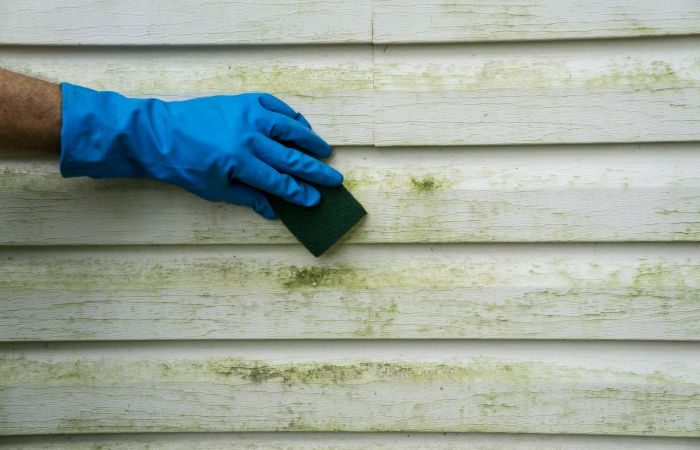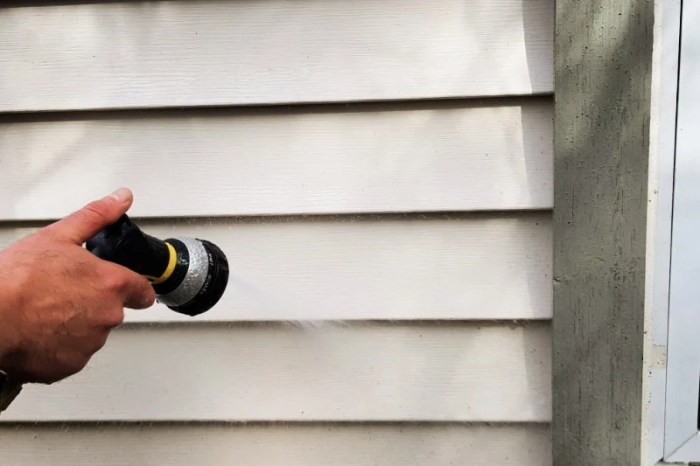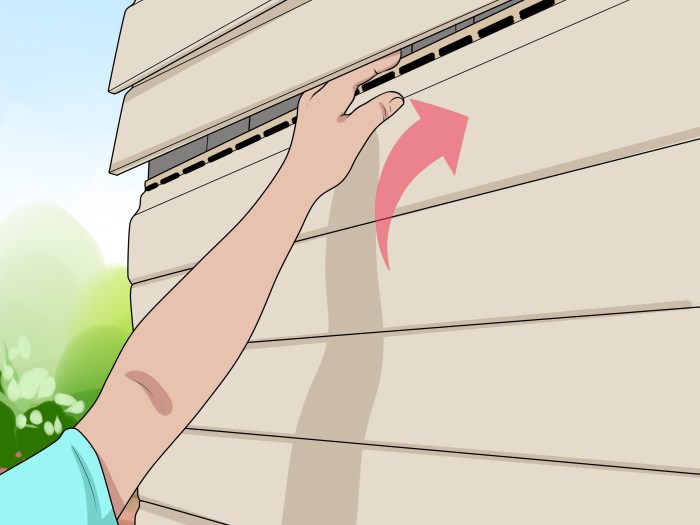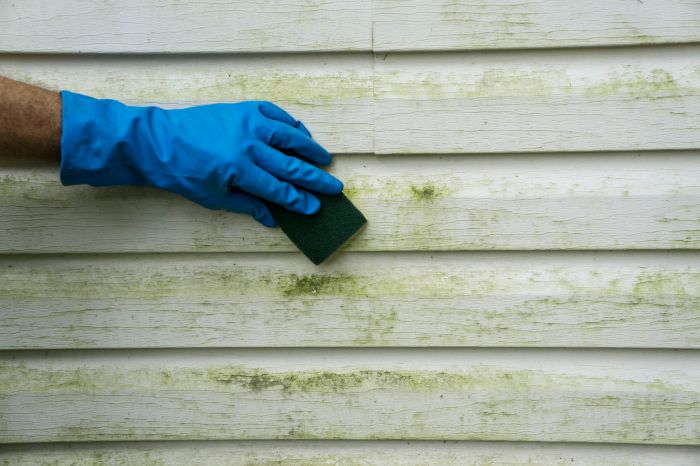How to Clean Vinyl Siding A Step-by-Step Guide

How to clean vinyl siding? It’s easier than you think! Keeping your home’s exterior looking fresh and new involves more than just admiring it. This guide walks you through everything from prepping your space and choosing the right cleaning method to tackling stubborn stains and ensuring long-lasting results. We’ll cover pressure washing, soft washing, and even good old-fashioned scrubbing, helping you select the best approach for your specific needs and the level of grime you’re facing. Get ready to bring back the shine to your vinyl siding!
We’ll delve into the details of different cleaning solutions, explaining their strengths and weaknesses. Learn how to safely mix cleaning solutions and understand which ones are best suited for various types of dirt and grime. From mildew and mold to algae and general dirt, we’ve got you covered. We’ll also show you how to handle tricky areas and prevent future build-up, keeping your siding looking its best for years to come. Let’s get started!
Preparing to Clean Vinyl Siding
Cleaning vinyl siding might seem straightforward, but proper preparation is key to achieving a sparkling clean finish and preventing damage. Taking the time to prepare beforehand will make the cleaning process much more efficient and effective, and importantly, safer.
Thorough preparation minimizes the risk of accidents and ensures you have everything you need for a successful cleaning job. It also helps protect your property and yourself from potential hazards.
Safety Precautions for Cleaning Vinyl Siding
Safety should always be your top priority when cleaning your home’s exterior. Working at heights, using cleaning solutions, and handling equipment all pose potential risks.
Before you even think about touching a cleaning tool, take a moment to assess your situation. Are you comfortable working on a ladder? Do you have a helper? Understanding your limitations and planning accordingly will prevent accidents.
- Always use a sturdy ladder in good condition, and ensure it’s placed on a stable, level surface. Never overreach while on a ladder.
- Wear appropriate safety gear, including safety glasses to protect your eyes from splashing cleaning solutions and debris, and work gloves to protect your hands.
- If using a pressure washer, wear protective earplugs to reduce the risk of hearing damage from the loud noise.
- Be mindful of electrical wires and avoid spraying water near electrical outlets or appliances. Turn off any outdoor power sources before beginning the cleaning process.
- Never use a pressure washer on windows or delicate areas of your siding. The high-pressure water stream can cause damage.
Essential Cleaning Supplies and Their Uses
Gathering the right supplies beforehand ensures a smooth and efficient cleaning process. Using the wrong tools or chemicals can damage your siding or be ineffective.
The list below details the necessary supplies and their specific applications. Having these items readily available will save you time and frustration.
- Garden Hose with Adjustable Nozzle: Provides the water source for rinsing and washing away dirt and grime. The adjustable nozzle allows you to control the water pressure.
- Soft-Bristled Brush or Sponge: Gently scrubs away stubborn dirt and mildew without scratching the vinyl siding. Avoid stiff brushes that could damage the surface.
- Cleaning Solution (Mild Detergent): A mixture of mild dish soap and water is usually sufficient for most cleaning tasks. Avoid harsh chemicals that could damage the vinyl.
- Pressure Washer (Optional): A pressure washer can help remove heavier dirt and grime, but use it cautiously and at a low pressure setting to avoid damaging the siding. If unsure, skip the pressure washer and opt for manual scrubbing.
- Bucket: For mixing the cleaning solution and holding clean water for rinsing the brush or sponge.
- Ladder (if needed): Provides safe access to higher areas of the siding.
Preparing the Area Around the House
Preparing the area surrounding your house is crucial for a safe and efficient cleaning process. This involves removing obstacles and protecting plants and other features.
Proper preparation will prevent accidents and damage to your landscaping and other property features. Take your time and plan carefully before you begin cleaning.
- Clear the area: Remove any objects, such as furniture, potted plants, or toys, from the area around the house where you will be cleaning. This prevents damage to these items and provides a safe working space.
- Protect plants and landscaping: Cover delicate plants and landscaping features with tarps or plastic sheeting to protect them from splashing water and cleaning solutions. This also helps to prevent any accidental damage from your equipment.
- Check for obstacles: Inspect the area for any potential hazards, such as loose branches, rocks, or uneven ground. Address these issues before beginning to prevent accidents.
- Consider the weather: Avoid cleaning on windy days, as this can make it difficult to control the water and cleaning solution. A slightly overcast day is ideal, as direct sunlight can cause the cleaning solution to dry too quickly.
Cleaning Methods for Vinyl Siding
Choosing the right cleaning method for your vinyl siding depends on several factors, including the level of dirt and grime, the size of the area, and your comfort level with different cleaning techniques. We’ll explore three common methods: pressure washing, soft washing, and scrubbing, comparing their effectiveness, cost, and time commitment.
Pressure Washing
Pressure washing uses a high-powered stream of water to blast away dirt and debris. It’s a fast and effective method for removing heavy grime, mildew, and even some types of paint. However, the high pressure can damage vinyl siding if not used correctly. Overly aggressive pressure washing can crack or dent the siding, leading to costly repairs. It’s best suited for larger areas with significant soiling, but requires caution and expertise to avoid damage. For example, a house with heavy algae growth after a particularly rainy summer might benefit from pressure washing, but only if performed by a professional who understands the proper techniques and pressure settings for vinyl.
Soft Washing
Soft washing, on the other hand, uses a low-pressure spray combined with a cleaning solution to gently remove dirt and mildew. This method is gentler on the vinyl siding and less likely to cause damage. While it may take longer than pressure washing, it’s safer and more suitable for delicate siding or areas with intricate details. For instance, a homeowner with lightly soiled siding and concerns about damaging the surface would find soft washing a more appropriate and safer option. The cleaning solution typically contains bleach, which is effective against mildew and algae, but requires proper rinsing to avoid staining.
Scrubbing
Scrubbing is the most labor-intensive method, involving manually cleaning the siding with a brush and a cleaning solution. It’s best for small areas or when dealing with stubborn stains that don’t respond to other methods. While it’s the least expensive option, it requires significant time and effort. This method is ideal for spot cleaning, such as removing bird droppings or localized stains on a small section of siding. For example, cleaning a small area affected by a tree sap spill would be efficiently handled by scrubbing.
Comparison of Cleaning Methods
The table below summarizes the key differences between the three cleaning methods:
| Method | Effectiveness | Cost | Time Required |
|---|---|---|---|
| Pressure Washing | High (for heavy grime) | Medium to High (equipment rental or professional service) | Low (for large areas) |
| Soft Washing | Medium to High | Medium (chemicals and equipment) | Medium |
| Scrubbing | Low to Medium (for localized stains) | Low (minimal equipment needed) | High |
Cleaning Solutions for Vinyl Siding: How To Clean Vinyl Siding

Source: housewifehowtos.com
Choosing the right cleaning solution is crucial for effectively removing dirt and grime from your vinyl siding without causing damage. The type of solution you use will depend on the severity of the dirt and the type of stain you’re dealing with. Using too harsh a solution can lead to discoloration or damage to the vinyl, while a solution that’s too weak may not be effective.
Different cleaning solutions offer varying levels of cleaning power and potential risks. Water alone is often sufficient for light cleaning, while more stubborn stains might require a stronger solution like a mixture of water and detergent. Bleach, while effective for removing mildew, should be used cautiously due to its potential to damage the siding if not diluted properly.
Water
Water is the gentlest and safest cleaning solution for vinyl siding. A pressure washer (used correctly, see previous sections) with plain water is often enough to remove loose dirt, dust, and cobwebs. For less stubborn dirt, a simple garden hose and a scrub brush will suffice. This method is ideal for routine cleaning and is a good first step before considering stronger solutions.
Detergent Solutions
For more persistent dirt and grime, a mild detergent solution is generally effective. Mix a small amount of dish soap or laundry detergent (avoid harsh chemicals or abrasive cleaners) with warm water. The exact ratio will depend on the detergent used, but a good starting point is 1-2 tablespoons of detergent per gallon of water. Apply the solution with a soft-bristled brush or sponge, scrubbing gently to avoid scratching the siding. Rinse thoroughly with clean water afterward. This method is effective for removing most common dirt, pollen, and light stains.
Bleach Solutions (Use with Caution)
Bleach solutions are powerful and effective against mildew and stubborn stains, but they can damage vinyl siding if used incorrectly. Never use full-strength bleach. Always dilute bleach with water; a common ratio is one part bleach to three parts water. Test the solution on an inconspicuous area first to check for any adverse reactions. Apply the diluted bleach solution carefully, avoiding prolonged contact with the siding. Rinse thoroughly with plenty of clean water after cleaning. Improper use can lead to discoloration or weakening of the vinyl.
Cleaning Solution Comparison
| Cleaning Solution | Cleaning Power | Potential Risks |
|---|---|---|
| Water | Low | None |
| Mild Detergent Solution | Medium | Minimal (if used correctly) |
| Diluted Bleach Solution | High | High (discoloration, damage if misused) |
Always test any cleaning solution on a small, inconspicuous area of your siding before applying it to the entire surface. This will help you assess its effectiveness and potential for causing damage.
Cleaning Vinyl Siding
Cleaning your vinyl siding can significantly improve your home’s curb appeal and protect it from damage. Regular cleaning removes dirt, mildew, and other grime that can dull the surface and potentially lead to deterioration. Choosing the right method depends on the level of dirt and your comfort level with different cleaning tools.
Pressure Washing Vinyl Siding, How to clean vinyl siding
Pressure washing is a quick and effective method for removing heavy dirt and grime from vinyl siding. However, it’s crucial to use the correct pressure and technique to avoid damaging the siding.
- Prepare the area: Clear away any loose debris, such as leaves or branches, from the siding and surrounding areas. Protect landscaping with tarps or plastic sheeting.
- Choose the right nozzle: Use a 15-25 degree nozzle on your pressure washer. A wider nozzle will reduce the risk of damage. Avoid using a narrow, high-pressure nozzle.
- Test in an inconspicuous area: Before starting, test the pressure washer on a small, hidden section of siding to ensure it doesn’t damage the surface. Adjust the pressure as needed.
- Wash from bottom to top: Begin at the bottom of the siding and work your way up in overlapping strokes. This helps prevent streaks and ensures even cleaning.
- Maintain a consistent distance: Keep the nozzle about 12-18 inches from the siding to avoid damaging it.
- Rinse thoroughly: Once you’ve cleaned the entire surface, rinse the siding thoroughly with clean water to remove any remaining cleaning solution or debris.
Image Description: The image shows a person using a pressure washer with a 15-degree nozzle, maintaining a consistent distance of about 18 inches from the vinyl siding. They are washing from bottom to top in overlapping strokes, with a tarp protecting the surrounding plants. The siding is visibly cleaner after the pressure washing.
Soft Washing Vinyl Siding
Soft washing uses a low-pressure spray with a cleaning solution to gently remove dirt and mildew. This method is gentler on the siding and is ideal for more delicate surfaces or areas with significant mildew growth.
- Mix the cleaning solution: Combine a mixture of water and a mildew-killing solution, following the manufacturer’s instructions carefully. A common solution is a mixture of bleach and water, but always check the siding manufacturer’s recommendations first.
- Apply the solution: Using a pump sprayer or garden hose with a nozzle attachment, apply the cleaning solution evenly to the siding, allowing it to dwell for the recommended time (usually 15-30 minutes).
- Scrub stubborn areas: If necessary, use a soft-bristled brush to gently scrub away stubborn dirt or mildew. Avoid harsh scrubbing that could scratch the siding.
- Rinse thoroughly: After the dwell time, rinse the siding thoroughly with clean water from the bottom up. Ensure all traces of the cleaning solution are removed.
Image Description: The image depicts a person using a pump sprayer to apply a cleaning solution to vinyl siding. The solution is a light, milky color. The person is wearing protective gloves and eyewear. The image shows the siding before and after application, highlighting the difference in cleanliness. A soft-bristled brush is visible nearby.
Cleaning Vinyl Siding with a Brush and Cleaning Solution
For lightly soiled siding, a simple brush and cleaning solution can be sufficient. This method is the most gentle and requires minimal equipment.
- Prepare the cleaning solution: Mix a mild detergent with water in a bucket. Avoid harsh chemicals that could damage the siding.
- Apply the solution: Using a sponge or soft-bristled brush, apply the cleaning solution to the siding in sections. Work from top to bottom to avoid streaks.
- Scrub gently: Use a gentle back-and-forth motion to remove dirt and grime. Avoid excessive scrubbing.
- Rinse thoroughly: Once you have cleaned a section, rinse it thoroughly with clean water using a garden hose.
Image Description: The image shows a person cleaning a section of vinyl siding with a soft-bristled brush and a bucket of soapy water. They are working from top to bottom, rinsing each section with a garden hose as they go. The siding is relatively clean, indicating a light level of soiling.
Addressing Specific Cleaning Challenges

Source: cloudinary.com
Cleaning vinyl siding is usually straightforward, but some situations require extra care and specific techniques. This section covers tackling stubborn stains, cleaning hard-to-reach areas, preventing future grime, and handling damaged siding.
Stubborn Stain Removal
Mildew, mold, and algae are common culprits behind unsightly stains on vinyl siding. These organisms thrive in damp, shady areas. Effective removal often requires a stronger cleaning solution than basic soap and water. A solution of bleach and water (typically a 1:1 ratio, but always check product instructions) is often effective, but should be applied carefully to avoid damaging the siding or surrounding plants. Always test the solution on an inconspicuous area first. For persistent stains, consider using a pressure washer, but maintain a safe distance to avoid damaging the siding. Remember to rinse thoroughly with clean water afterward. For particularly stubborn mold or mildew, a specialized vinyl siding cleaner might be necessary.
Cleaning Hard-to-Reach Areas
High areas, corners, and areas behind downspouts can be difficult to clean. For high areas, a long-handled brush or a pressure washer with an extension wand can help reach those spots safely from the ground. For corners and tight spaces, a soft-bristled brush or even a scrub brush with a long handle can be used. A garden hose with a nozzle attachment can provide the necessary water pressure for rinsing. Consider using a ladder only if necessary and always follow safety guidelines for ladder use. Never reach too far or overextend yourself.
Preventing Future Dirt Buildup
Regular cleaning is key to preventing significant dirt and grime buildup. A simple rinse with a garden hose every few months can remove loose dirt and prevent staining. Trimming overhanging branches and bushes helps reduce shade and moisture, which inhibits mold and mildew growth. Consider installing gutter guards to prevent leaves and debris from accumulating and blocking gutters, leading to water damage and staining. Regular gutter cleaning is also crucial for preventing water runoff from staining the siding.
Damaged or Cracked Vinyl Siding
Cleaning damaged vinyl siding requires extra caution. Avoid using high-pressure water near cracks or damaged areas as this can worsen the damage. Use a soft brush and gentle cleaning solution to avoid further damage. If the damage is significant, it’s best to consult a professional for repair before attempting a thorough cleaning. Cleaning carefully around damaged areas can help prevent further deterioration and prolong the life of your siding. Inspect the siding regularly for any signs of damage and address them promptly to prevent bigger issues.
Post-Cleaning Care and Maintenance

Source: wikihow.com
Proper post-cleaning care is crucial for maintaining the beauty and longevity of your vinyl siding. Neglecting this step can lead to water damage, mildew growth, and a less-than-perfect finish. Taking the time to thoroughly rinse and dry your siding will protect your investment and keep it looking its best for years to come.
Thorough Rinsing
Rinsing away all traces of cleaning solution is essential. Residual cleaning chemicals can leave unsightly streaks or even damage the vinyl over time, especially if they contain harsh ingredients. Use a garden hose with a nozzle that provides a strong, even spray. Pay close attention to corners, crevices, and areas where dirt tends to accumulate. Ensure that all surfaces are completely free of soap residue. A final, light rinse with clean water will help eliminate any lingering cleaning solution.
Drying the Vinyl Siding
While vinyl siding is designed to be water-resistant, prolonged exposure to moisture can still lead to problems. After rinsing, allow the siding to air dry naturally whenever possible. This is the best way to prevent water damage and the growth of mold or mildew. If you’re in a hurry or facing inclement weather, you can gently assist the drying process with a soft-bristled brush or a clean microfiber cloth. Avoid using high-pressure washing or abrasive tools that could scratch the surface.
Regular Maintenance Recommendations
Regular maintenance is key to keeping your vinyl siding looking its best. A simple rinse with a garden hose every few months can remove loose dirt and debris, preventing the buildup of grime. For more stubborn stains or dirt, you can use a soft brush and a mild detergent solution, following the cleaning methods as described in the article previously. Annual inspections will allow you to identify and address any potential issues early on, preventing them from becoming major problems. This proactive approach can significantly extend the lifespan of your vinyl siding.
Post-Cleaning Checklist
This checklist will help ensure you haven’t missed any important steps:
- Completely rinse all surfaces of the vinyl siding to remove all traces of cleaning solution.
- Allow siding to air dry naturally whenever possible.
- If necessary, gently assist drying with a soft-bristled brush or microfiber cloth.
- Inspect siding for any remaining dirt, mildew, or damage.
- Schedule a follow-up cleaning or maintenance as needed based on your siding’s condition and environmental factors.
Wrap-Up

Source: universalwindowsdirect.com
Cleaning your vinyl siding doesn’t have to be a daunting task. By following the steps outlined in this guide, and understanding the various methods and solutions available, you can easily maintain the beauty and integrity of your home’s exterior. Remember to prioritize safety, choose the appropriate cleaning method for your situation, and always rinse thoroughly. With a little effort and the right techniques, you can keep your vinyl siding looking its best for years to come. Now go forth and clean!
Comments are closed.